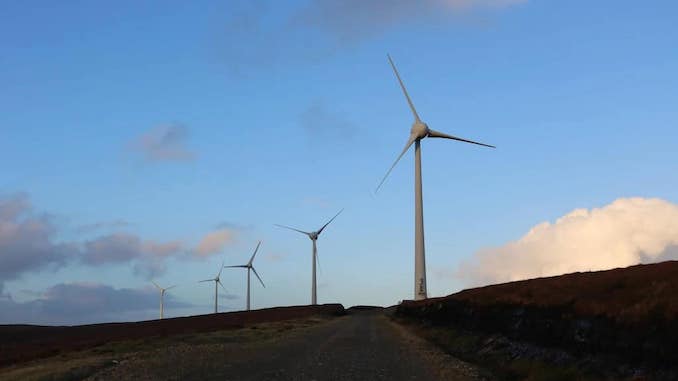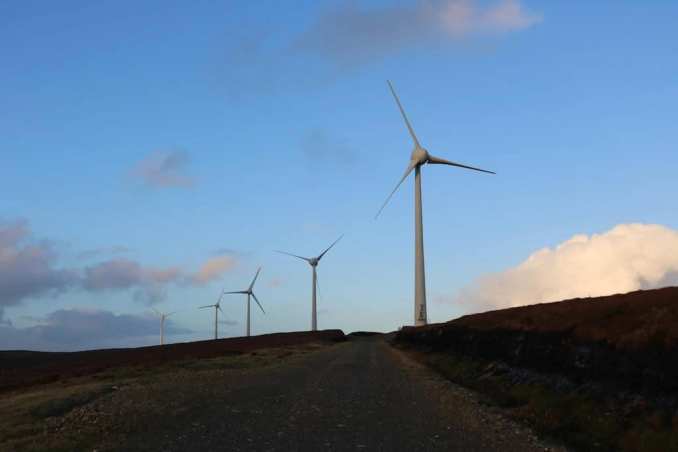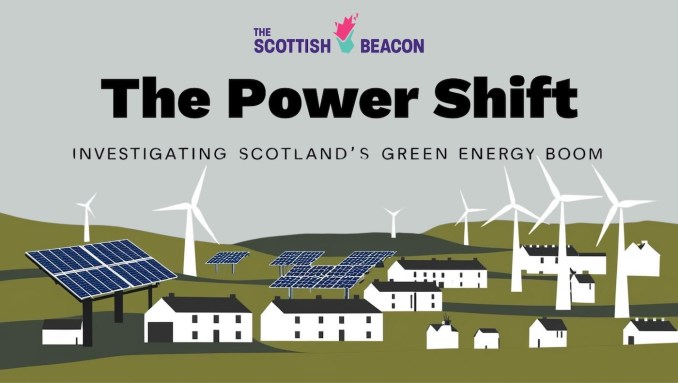by Mike Small, The Scottish Beacon
The Power Shift is a new project connecting independent media outlets to share knowledge and experience of the renewables revolution in Scotland.
Our media partners represent communities that are all grappling with shared issues: how the massive onshore renewables transition might be of greater benefit to the people who are experiencing the impact of the emerging infrastructure.
The issue is becoming more and more prominent and pressing this summer as people try to realise the potential for renewables to be something for communities not something done to communities.
As a report by Equitable Energy Research in May put it: “As the scale and pace of new energy developments increase, the question of what constitutes a fair deal for communities hosting such projects becomes ever more critical.”
Our partners include local media from across the country, such as Kyle Chronicle, Shetland News, Bylines Scotland, Glenkens Gazette, Forres Local, Am Pàiper (Uist), The Bellman (Stonehaven), Fios (Lewis), Greater Govanhill and the Lochside Press.
Shared stories from different communities
In Sutherland, Kyle Chronicle readers are seeing an unprecedented number of planning applications for renewable energy developments and for transmission infrastructure. As editor Silvia Muras says: “The proposed developments are of such a scale that they would dwarf the small, dispersed crofting communities and transform the area into an industrial landscape.
“The Kyle of Sutherland is a stronghold of endangered species such as Fresh Water Pearl Mussel and Atlantic Salmon, and home to wildlife such as Red Squirrel, Pine Marten, Hen Harrier, Osprey, Curlew and Golden Eagle.”
“Despite having several operational wind farms and hydro schemes at our doorstep, standing charges in Sutherland are among the highest in the country, and as many as 65% of households were living in fuel poverty in 2023.”
Jane Cruikshank from The Bellman in Stonehaven explains the issues their community is navigating: “The Bellman is going to focus on, ‘that which cannot be considered’ – i.e wind farm community benefits. Like many communities, Stonehaven relies more and more on the voluntary sector to provide services and amenities. This brings with it a constant need to find funding for projects.
“The developers behind the Craigneil windfarm are offering a very generous community benefit fund that would bring millions to the town over 25-years. Unfortunately, the structures will be very large, so impact on the environment will be a significant concern when an application goes in shortly to vary an existing permission.
“Councillors understand there is a local appetite for the benefit fund, which would mitigate the impact, but they are not allowed to consider this in their determination of a planning application.”
Siân Swinton, editor of Am Pàipear (‘the paper’ in Gàidhlig) based in Uist but covering the Outer Hebrides, explains her publication has been reporting on the issues that matter to the people of Uist for almost 50 years: “When we first launched, climate change was not a common topic to read about in our local press, but having been on the receiving end of many a negative consequence of the warming of our planet it is now a topic on everyone’s lips.
“As one of the windiest places in Scotland we, unsurprisingly, have turned to wind energy. But does the community benefit from these projects? Where is the money actually going? And how do those who deny the warming of our planet feel about these projects?
“Am Pàipear will investigate where the money from our local turbines is actually going and we’d like to speak to those who do not believe in climate change to see if potential community benefit will influence how they feel about green energy projects.”
Shetland News has a long history of reporting on every chapter of this evolving story, which began in 2003 with the idea of building two large wind farms, and took more than 20 years until the Viking Energy wind farm was up and running. Read the background to the Viking Energy Wind Farm here.
Hans Marter, editor of Shetland News explains their publication’s role in the Power Shift project: “We’ll be reporting on Shetland’s renewable future and the feeling of large sections of the community of feeling deprived of having their say on what is happening on their home islands.”
Like many places, this is a complex issue and a mixed blessing. Marter explains: “I am hoping to be able to be present when the keys are handed over to the first tenants of a house bought by the proceeds of the community-owned wind farm on the island of Yell.”
Marter will also be discussing these issues with Chris Bunyan, the driving force behind the Shetland Community Benefit Fund which is in receipt of £2.4m annually of Viking Energy community benefit. This is now the largest fund of its kind in Europe.
The Lochside Press will be covering the ongoing applications for ever-larger wind turbines on the edge of Loch Lomond and the Trossachs National Park, with one site on the Cowal Peninsula seeing renewed applications despite earlier refusals after strong objections by Nature Scot and air traffic control body NATS. See Giant’s Burn Wind Farm Plans Revised.
The Lochside Press will also be exploring the ongoing uncertainty following the decision by Petroineos to close the Finnart oil terminal: the site on Loch Long is owned by the Ministry of Defence, while the 58-mile pipeline connecting it with Grangemouth saw a multi-agency response after a leak of crude oil last year. See Will the MoD expand its presence on Loch Long?
From the Glenkens Gazette in New Galloway, editor Sarah Ade will be looking at the impact of commercial forestry with regard to its actual green credentials, land use changes, and cumulative impact. The Glenkens Gazette will also be looking at Carsphairn Parish as a case study, where with all the existing and consented wind farms, there will be an equivalent of one turbine for every resident; and looking at what this means for the lived experience of people with regard to road use for construction of sites, attitude of contractors, pylon lines and substations and their impact.
Environmental justice
The renewables energy sector is huge and growing. According to Equitable Energy Research the combined capacity of operational onshore and offshore wind projects in the Highlands and Islands is around 5GW. If all projects currently in the pipeline were to be built, the total capacity could exceed 25GW.
But despite the fact that we know that “community energy generates 100x more wealth than corporate counterparts” – the actual amount of community-owned onshore wind is pitifully small.
Community-owned wind in Scotland is 0.2% contrasting with 52% in Denmark. This has led to calls at the Public Petitions Committee at Holyrood in June to make offering community shared ownership mandatory for all new wind farm developments.
According to the Scottish Coalition on Energy: “Community shared ownership of private renewable energy has been a recognised Scottish Government ambition since 2014 and forms a key objective in the Scottish Government’s Energy Strategy and Just Transition Plan.”
The Scottish Government reiterated its commitment to shared ownership in their 2017 Onshore Wind Policy Statement stating: “Our ambition remains to ensure that, by 2020, at least half of newly consented renewable energy projects will have an element of shared ownership. Shared ownership will form a key part in helping to meet our targets of 1 GW of community and locally owned energy by 2020, and 2 GW by 2030.”
As the Scottish Coalition on Energy states: “To date, 20 community bodies have entered into a community shared ownership arrangement with a commercial developer. In the context of Scotland’s 9600MW of total installed onshore wind this equates to only 23 MW – only 0.2% of Scotland’s current wind power is owned by communities through a shared ownership arrangement.”
This is a significant policy failure and one that risks missing the opportunity to bring considerable long-term resource to regions of Scotland suffering the triple effect of fuel poverty, a crisis in affordable housing and depopulation.
The Scottish Government’s own analysis shows that of the 32 local authorities in Scotland, seven have significantly higher levels of fuel poverty than the national average. Six of these are in the Highlands and Islands.
It’s important to note that it’s not all bad. There are many examples of highly successful and impactful community-owned projects that can be replicated, as the equitable energy report covers:
Tilley, the Tiree Community Wind Turbine, returns over 100x more economic value to the community than the privately-owned Beinn An Tuirc 1-2 Wind Farm, despite being around 1% of the size.
Community-owned Garth Community Wind Farm in Yell returns around 90x more value per MW to the community than the privately-owned Viking Wind Farm, despite being 100 times smaller.
Orkney Community Wind Farms, wholly-owned by Orkney Islands Council, are set to deliver £5.5m in revenue each year, helping to support public services across the islands.
But if the business-as-usual model prevails, then the vast potential of the renewables revolution will be wasted. Large sectors of the renewable energy industry is foreign-owned (none of the proposed wind farms include ownership participation from Scottish entities), and the Community Benefit Payments – direct payments paid annually to communities have not been updated since 2010 when £5,000 per MW per annum was established as an industry benchmark by Forestry and Land Scotland.
The system of conversion to renewable energy – the power shift – seems at best un-strategic and at worst incoherent.
Most of those we’ve spoken to in communities across Scotland, are not against renewables, but see a just transition and the rapid shift from fossil fuel dependency as an essential part of the fight to combat climate breakdown.
However the issue that our partners are reporting on relate to the need for the democratisation of energy – and for communities to gain control over the technologies and infrastructures that threaten to overwhelm them for corporate gain. Currently, many feel their voices are not being heard. This is ultimately a question of environmental justice, and as Erin Devlin of Equitable Energy Research put it, a question of: “Who should benefit from the resources of a place?”
We also want to hear from you. How has the green transition impacted your community? Please take a moment to share your stories via the survey link here.
This article is part of The Power Shift – a collaborative investigation by 10 independent, community-based publishers across Scotland, exploring the impact of the green energy transition on communities. Co-ordinated by the Scottish Beacon and supported by the Tenacious Journalism Awards, the project aims to amplify local voices, facilitate cross-community learning and push for fair, transparent energy development.
Related


